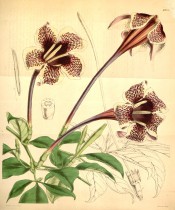Rothmannia longiflora Salisb.
Shrub or small tree with elliptic leaves, to 14cm, and terminal, solitary, fragrant, tubular-funnel-shaped flowers with green or red-purple tubes and white lobes, red to purple inside. To 5m. [RHSD].
Horticultural & Botanical History
‘Sent to the Right Honourable the Earl of Derby by Mr. Whitfield from Sierra Leone, and assuredly one of the most remarkable and beautiful of the plants which that gentleman has had the satisfaction of introducing to our collections. The young plant presented to us, when yet only a few months old, but placed on the table of a stove heated below by the tank-system, threw out flower-buds from most of the dichotomies of its young horizontal branches; and in the month of March 1845 no fewer than ten of the noble flowers, here represented, were expanded at a time on one and the same plant. Our drawing was made at that period, but was scarcely finished when we sent the plant, for the gratification of those who might not be able to see it at Kew, to the rooms of the Horticultural Society in London, where it did not fail to attract great attention. Unfortunately the season was unusually cold; the blossoms were materially injured in the transit, so much so that our figure would have still been unfit for publication, were it not that Messrs. Lucombe and Pince, with a liberality common to other distinguished nurserymen, as well as to themselves, sent me from Exeter a flowering plant which we had the pleasure of presenting to them a short time before as a cutting: so freely does this species of Gardenia produce its charming blossoms. It deservedly bears the name of the scientific nobleman through whose means it was introduced, and in whose, as well as other collections, it has now flowered. How closely it is allied to Rothmannia longiflora of Salisbury, in ’ Paradisus Londinensis,’ Tab. 65. (strangely separated from Gardenia Rothmannia, Linn., in Bot. Mag. p. 690, and there referred to Randia) is very evident; but, if the characters of that, as given by Salisbury, who only saw it “when all the flowers were fading,” be considered, it cannot be the same; for, independent of the exserted stamens of that species, the smaller size of the corolla (five to six inches long, whereas ours is nine inches), and the very different colour of the tube, which is described as being cottony and the limb slightly cottony on both sides, will readily distinguish it. Nothing of the kind is seen in our plant.’ [BM t.4185/1845.]
‘The first intelligence which the public received of the existence of this noble stove plant was derived from the Horticultural Society, at one of whose meetings in London a specimen was exhibited by permission of Sir William Hooker of Kew.’ [BR f.47/1845]. Introduced to Britain in 1843. [JD]. FC p.289/1845. MB p.169/1846. FS pl.1 1re Liv./1846.
History at Camden Park
Listed in the 1850 and 1857 catalogues [T.508/1850]. It may have been obtained from the London Horticultural Society or Kew Gardens. It was included among desiderata in a letter to John Lindley dated 15th February 1848 [MP A2933-1, p.157] and to Kew at about the same time but was not marked ‘arrived’ [MP A2933-1, p.165]. It was requested again of Kew on 1st February, 1849 [MP A2933-1, p.177] and of John Lindley on the same date [MP A2933-1, p.182a].
Notes
Published Feb 08, 2010 - 10:17 AM | Last updated Feb 08, 2010 - 10:34 AM
| Family | Rubiaceae |
|---|---|
| Category | |
| Region of origin | Tropical west Africa |
| Synonyms |
|
| Common Name | |
| Name in the Camden Park Record |
Gardenia Stanleyana |
| Confidence level | high |


